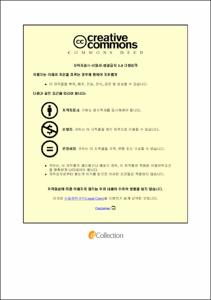디자인 씽킹을 적용한 중학교 유니버설디자인 프로그램 개발
- Alternative Title
- Development of Universal Design program for Middle School applying Design Thinking
- Abstract
- ‘초연결’, ‘초지능’, ‘초융합’으로 서술되는 현대 사회는 복잡하고 빠르게 변화하는 중이다. 다가올 미래 사회는 유연한 사고를 바탕으로 다양한 지식을 융합하여 새로운 가치를 창출하는 인재를 필요로 한다. 그 인재상의 핵심역량은 창의력과 문제 해결 능력의 내재화이다. 최근 난해하고 불확실성을 보이는 변혁의 시대에 대비할 수 있는 인재 양성을 위한 교육적 도구로 디자인 씽킹은 주목받고 있다. 디자인 씽킹은 비구조화된 문제에 대해 디자이너의 감수성을 활용하여 분석적이며 직관적인 사고의 조합으로 최적의 해결안을 끌어내는 방법론이다. 관찰과 공감으로 문제의 근본적인 원인을 발견하고, 해결 과정에서 혁신적인 아이디어를 도출하는 능력을 기를 수 있다는 측면에서 유용하다. 이러한 디자인 씽킹은 타인에 대한 공감과 이해를 바탕에 둔다는 점에서 사용자 지향을 근간으로 하는 유니버설디자인과 맥락을 같이 한다. 이에 본 연구는 디자인 씽킹을 적용하여 유니버설디자인의 결과물을 산출하는 과정을 수업 프로그램으로 개발하였다. 본 프로그램은 Stanford d.school의 디자인 씽킹 모델을 기반으로 재구성한 프로세스에 따라 총 9차시로 구성하였다. 중학교 학생을 대상으로 하여, 학습자의 삶과 직결된 상황에 인간 중심적 차원으로 문제를 해결하는 학습자 중심의 교육 방안을 모색하였다. 이에 학교 공간 내 시설이나 물건으로 불편함을 느낄 수 있는 대상을 탐색하고, 이들이 생활하며 느끼는 잠재적인 불편사항을 개선할 수 있도록 설계하였다. 유니버설디자인을 활용하여 학교 문제를 해결하는 디자인 씽킹 기반 프로젝트 수업은 학습자로 하여금 다음과 같은 교육적 효과를 기대할 수 있다. 첫째, 인간 중심적인 사고로 문제에 접근하여 해결안을 도출하기 때문에 공감 능력과 창의적인 문제 해결 능력을 함양할 수 있다. 둘째, 협동 과정을 통하여 집단지성을 경험하고 서로 협력하고 존중하는 태도를 형성할 수 있다. 셋째, 사회의 다양성을 인지하고 학교 구성원이 겪을 수 있는 상황을 개선함으로써 공동체 의식을 제고할 수 있다. 넷째, 일회적 결과 중심 수업이 아닌 반복적인 과정 학습으로 수업의 흥미와 학습 의지를 향상할 수 있다. 본 연구는 학습자가 주체적으로 주변 세계의 문제를 인식하고 해결하는 동시에 다양한 사회 구성원과 함께하는 사회를 만들어 나가는 데 목적이 있다. 본 연구가 미래를 책임지고 이끌어갈 청소년들의 전인적 성장을 위한 유의미한 교육자료로 활용되기를 희망하는 바이다.|Modern society, described as ‘Hyper-connection’, ‘Super-intelligence’, and ‘Hyper-convergence’, is changing complexly and rapidly. In the future, society will require talented individuals who create new values by using flexible thinking to converge diverse knowledge. The core competency of those talented individuals is the internalization of creativity and problem-solving ability. Recently, design thinking is attracting attention as an educational tool for fostering talents that can prepare for an era of change that is increasingly difficult and uncertain. Design thinking is a methodology that uses the designer's sensibility for unstructured problems to derive optimal solutions through a combination of analytical and intuitive thinking. It is useful in that it enables you to develop your ability by discovering the root cause of a problem through observation and empathy and deriving innovative ideas. Design thinking is in line with a universal design based on user-centered in that it is based on empathy and understanding for others. Therefore, this study developed a program that applies design thinking to produce universal design results. This program consists of nine classes, according to the reconstructing process based on the design thinking model of Stanford d.school. For middle school learners, we sought a learner-centered teaching method that solves problems of situations directly related to learners' lives with a human-centered approach. Therefore, it was designed to explore facilities or objects in the school space that may cause discomfort to the learners and to improve potential inconveniences they feel. Design thinking-based project classes that use universal design to solve school problems can expect learners to have the following educational effects. First, learners can develop empathy and creative problem-solving ability because they approach problems and derive solutions with human-centered thinking. Second, through the cooperative process, collective intelligence can be experienced and an attitude of cooperation and respect can be formed. Third, a sense of community can be enhanced by recognizing the diversity of society and improving the situations that school members may experience. Fourth, the learners can develop an interest in learning and increase their willingness to learn not through a one-time result-oriented class but through repetitive process learning. The purpose of this study is not only to create a society in which learners can recognize and solve problems in the surrounding world on their own but also to make a better society to live in with various social members. It is hoped that this study will be used as significant educational material for the holistic growth of adolescents to become responsible leaders in the future.
- Issued Date
- 2023
- Awarded Date
- 2023-02
- Type
- Dissertation
- Alternative Author(s)
- Yoon, Ji Hyun
- Affiliation
- 제주대학교 교육대학원
- Department
- 교육대학원 미술교육전공
- Advisor
- 이창희
- Table Of Contents
- Ⅰ. 서론 1
1. 연구의 필요성 및 목적 1
2. 연구 내용 및 방법 2
Ⅱ. 이론적 배경 3
1. 디자인 씽킹 3
2. 유니버설디자인 14
Ⅲ. 미술과 교육과정과 교과서 분석 19
1. 2015 개정 교육과정과 중학교 미술과 교육과정 19
2. 2015 개정 중학교 미술 교과서 분석 24
Ⅳ. 디자인 씽킹을 적용한 유니버설디자인 프로그램 개발 32
1. 프로그램 개발 방향 32
2. 차시별 교수학습 지도안 39
Ⅴ. 결론 51
참고문헌 53
ABSTRACT 57
부록 59
- Degree
- Master
- Publisher
- 제주대학교 교육대학원
- Citation
- 윤지현. (2023). 디자인 씽킹을 적용한 중학교 유니버설디자인 프로그램 개발.
- Appears in Collections:
- Education > Fine Arts Education
- 파일 목록
-
-
Download
 디자인 씽킹을 적용한 중학교 유니버설디자인 프로그램 개발.pdf
기타 데이터 / 2.62 MB / Adobe PDF
디자인 씽킹을 적용한 중학교 유니버설디자인 프로그램 개발.pdf
기타 데이터 / 2.62 MB / Adobe PDF
-
Items in Repository are protected by copyright, with all rights reserved, unless otherwise indicated.